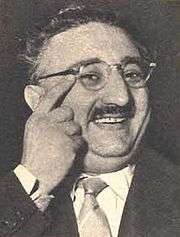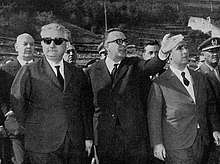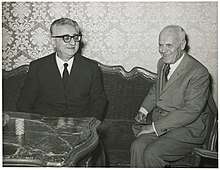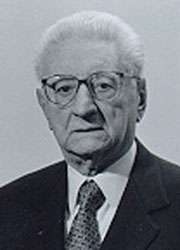Giovanni Leone
Giovanni Leone (Italian pronunciation: [dʒoˈvanni leˈoːne]; 3 November 1908 – 9 November 2001) was an Italian politician, jurist and university professor.[1] A founding member of the Christian Democracy (DC), Leone served as the 6th President of Italy from December 1971 until June 1978.[2]
Giovanni Leone | |||||||||||||||||||||||
|---|---|---|---|---|---|---|---|---|---|---|---|---|---|---|---|---|---|---|---|---|---|---|---|
 | |||||||||||||||||||||||
| 6th President of Italy | |||||||||||||||||||||||
| In office 29 December 1971 – 15 June 1978 | |||||||||||||||||||||||
| Prime Minister | Emilio Colombo Giulio Andreotti Mariano Rumor Aldo Moro Giulio Andreotti | ||||||||||||||||||||||
| Preceded by | Giuseppe Saragat | ||||||||||||||||||||||
| Succeeded by | Sandro Pertini | ||||||||||||||||||||||
| 37th Prime Minister of Italy | |||||||||||||||||||||||
| In office 24 June 1968 – 12 December 1968 | |||||||||||||||||||||||
| President | Giuseppe Saragat | ||||||||||||||||||||||
| Preceded by | Aldo Moro | ||||||||||||||||||||||
| Succeeded by | Mariano Rumor | ||||||||||||||||||||||
| In office 21 June 1963 – 4 December 1963 | |||||||||||||||||||||||
| President | Antonio Segni | ||||||||||||||||||||||
| Preceded by | Amintore Fanfani | ||||||||||||||||||||||
| Succeeded by | Aldo Moro | ||||||||||||||||||||||
| President of the Chamber of Deputies | |||||||||||||||||||||||
| In office 10 May 1955 – 21 June 1963 | |||||||||||||||||||||||
| Preceded by | Giovanni Gronchi | ||||||||||||||||||||||
| Succeeded by | Brunetto Bucciarelli-Ducci | ||||||||||||||||||||||
| |||||||||||||||||||||||
| Personal details | |||||||||||||||||||||||
| Born | 3 November 1908 Naples, Kingdom of Italy | ||||||||||||||||||||||
| Died | 9 November 2001 (aged 93) Rome, Italy | ||||||||||||||||||||||
| Political party | Christian Democracy | ||||||||||||||||||||||
| Spouse(s) | Vittoria Micchitto ( m. 1946) | ||||||||||||||||||||||
| Children | 4 | ||||||||||||||||||||||
| Alma mater | University of Naples | ||||||||||||||||||||||
| Signature | |||||||||||||||||||||||
He also briefly served as the 37th Prime Minister from June to December 1963 and again from June to December 1968.[3] He was also President of the Chamber of Deputies from May 1955 until June 1963.[4]
Leone was the first Italian president to resign for a scandal. In 1978, he was accused of bribery amid the Lockheed scandal; however the allegations were later declared false and Leone was completely rehabilitated.[5]
Early years
Leone was born in Naples in 1908, from Mauro Leone and Maria Gioffredi, both in Pomigliano d'Arco, his father, Mauro Leone was a prominent lawyer of the Naples Bar, and had participated in the foundation of the Italian People's Party in Campania.[6] Leone grew up in Pomigliano d'Arco, where he attended the classic lyceum, getting a diploma in 1924.[7]
In 1929, he graduate in law at the prestigious University of Naples Federico II, with the thesis "Violation of family care obligations", which was even published in 1931.[8] In the following year, he also graduated in social and political science.[9] During the university, Leone became a member of Catholic Action (AC). After the graduation, he started working in the law firm of Enrico De Nicola, becoming also a professor of criminal procedure at the University of Camerino.[10]
During the 1930s, he became one of the most prominent lawyers and jurists in Southern Italy, teaching at the Universities of Messina, Bari and Naples. In these years, he was also elected president of the Italian group of the International Association of Penal Law, as well as a member of the executive committee of the association.[11]
During the World War II, he became a magistrate of the military court of Naples, with the rank of lieutenant colonel. In the aftermath of September 1943 armistice, during the dramatic days of the Nazi occupation, he worked effectively for the release of numerous political prisoners and deserters, thus removing them from possible reprisals. In these years, thanks to a tribunal's colleague, he met Vittoria Michitto, belonging to one of the best known families of Caserta, whom he married in July 1946.[12] The couple had four sons: Mauro, Paolo, Giancarlo and Giulio, who died at the age of 4.[13][14]
Political career

In 1943, along with his father, Leone was among the founders of the Christian Democracy (DC), the PPI's heir led by Alcide De Gasperi.[15] After two years, in 1945, he was elected DC's provincial secretary for Naples, immediately becoming one of the leading figures of the party.
In 1946, Leone was among the main supporters of the "neutrality" in the 1946 institutional referendum, in which Italians voted to abolish the monarchy of the House of Savoy.[16][17] In the same year, he was elected with nearly 32,000 votes to the Constituent Assembly for the constituency of Naples–Caserta.[18] As a prominent jurist, he was appointed in the commission with the aim of drawing up the new republican constitution.[19]
In April 1948, he was elected to the Chamber of Deputies with 60,000 votes.[20] Even as a deputy, he continued working as a lawyer and teaching at the university, considering for a long time these occupations as priority aspects of his life. Also for this reason, according to some testimonies, he often expressed the desire not to take on government positions.[21] Being able to count on his own reliable and territorially rooted electorate, Leone practically never conducted a real party activity. He remained, therefore, substantially foreign to the large and small factions in which the DC quickly split up, although he could ideally be considered close to the party's conservative wing.
President of the Chamber of Deputies

Thanks to his super partes position, the respect of all DC's internal factions, alongside the undoubted consideration gained also from the other political forces during the works of the Constituent Assembly, in 1950, Leone assumed the position of Vice President of the Chamber of Deputies and then, from May 1955, the one of President, which he held continuously until June 1963.[22]
As president, he demonstrated, in addition to a strong sense of the institutions and a scrupulous respect for the rules of democratic confrontation, a remarkable ability to govern parliamentary dynamics, also mastered through that undeniable presence of spirit, contributed in making him a well-known figure in the public opinion. At the same time, he was able to gain approval for his action both within the party, which found him a reliable manager of parliamentary processes, and outside DC, among the majority's parties but also in the oppositions, which appreciated his qualities of institutional balance.[23]
Prime Minister of Italy
First term
In the 1963 general election, the Christian Democrats lost almost one million votes, gaining nearly 38%, while the Italian Communist Party (PCI) arrived second with 25%.[24] However the Italian Liberal Party (PLI) surged to 7%, their best results ever, receiving many votes from former Christian Democratic supporters, who were against Amintore Fanfani's centre-left policies. With the decline of electoral support, on 22 June 1963, the majority of DC members decided to replace Fanfani with a provisional government led by Leone.[25]
Leone formed a one-party cabinet, composed only by DC's members and externally supported by Italian Socialist Party (PSI), Italian Republican Party (PRI) and Italian Democratic Socialist Party (PSDI).[26][27] The cabinet was also known as "Bridge Government" (Governo ponte),[28] as a transitional government, with the aim of starting a tighter cooperation with the PSI.

As Prime Minister, Leone had to face one of the most tragic events in Italian republican history, the Vajont Dam disaster.[29] On 9 October 1963, a landslide occurred on Monte Toc, in the province of Pordenone. The landslide caused a megatsunami in the artificial lake in which 50 million cubic metres of water overtopped the dam in a wave of 250 metres (820 ft), leading to the complete destruction of several villages and towns, and 1,917 deaths.[30] In the previous months, the Adriatic Society of Electricity (SADE) and the Italian government, which both owned the dam, dismissed evidence and concealed reports describing the geological instability of Monte Toc on the southern side of the basin and other early warning signs reported prior to the disaster.[31]
Immediately after the disaster, government and local authorities insisted on attributing the tragedy to an unexpected and unavoidable natural event. However, numerous warnings, signs of danger, and negative appraisals had been disregarded in the previous months and the eventual attempt to safely control the landslide into the lake by lowering its level came when the landslide was almost imminent and was too late to prevent it.[32] The communist newspaper L'Unità was the first to denounce the actions of management and government.[33] Leone accused the PCI of political profiteering from the tragedy, promising to bring justice to the people killed in the disaster. However, a few months after the end of his premiership, he became the head of SADE's team of lawyers, who significantly reduced the amount of compensation for the survivors and ruled out payment for at least 600 victims.[34]
In December 1963, after only five months of government, when the congress of the PSI authorized a full engagement of the party into the government, Leone resigned and Aldo Moro, the secretary of the DC and leader of the more leftist wing of the party, became the new Prime Minister, ruling Italy for more than four years.[35]
1964 presidential election
In August 1964, President Antonio Segni suffered a serious cerebral hemorrhage while he was working at the presidential palace; he only partially recovered and decided to resign. Leone was selected as the DC's official candidate for the presidency, but Fanfani decided to run against him.[36] However, neither Fanfani nor Leone succeeded in being elected, in fact, during the 1964 presidential election, the social-democratic leader Giuseppe Saragat succeeded in gaining the majority of votes.[37][38]
In August 1967, Leone was appointed senator for life by President Saragat.[39]
Second term

In June 1968, after the general election, Saragat appointed Leone at the head of the government. As his first cabinet, also the second one was composed only by DC members and externally supported by PSU and PRI.[40]
In November 1968, the Parliament approved a law that introduced a special benefit for full unemployment for workers in the industrial sector, in cases of total or partial closing down of enterprises or large-scale dismissals, equalling two-thirds of previous monthly earnings for 180 days. The law also extended earnings replacement benefits to cases of sectoral crises or industrial restructuring with a new compensation formula equaling 80% of previous earnings for 3 months (9 months in exceptional circumstances), allowed for family allowances to be paid to those in receipt of unemployment benefits.[41]
Leone's second premiership lasted only seven months. In December 1968, he resigned and Mariano Rumor became the new Prime Minister.[42]
President of Italy

In 1971, Amintore Fanfani was proposed as Christian Democracy's candidate for the Presidency of the Republic. However his candidacy was weakened by the divisions within his own party and the candidacy of the socialist Francesco De Martino, who received votes from PCI, PSI and some PSDI members.[43] Fanfani retired after several unsuccessful ballots and, at the twenty-second round, Leone was selected as the Christian democratic candidate for the presidency, being slightly preferred to Aldo Moro. At the twenty third round he was finally elected with a centre-right majority, with 518 votes out of 996, including those of the neo-fascist Italian Social Movement (MSI).[44] Leone's majority was the narrowest one ever obtained by an elected President and with twenty-three rounds of voting the 1971 presidential election remains still today the longest presidential election in the Italian republican history.[45]
Leone's presidency was considered quite revolutionary for the role held by his wide, Vittoria. Before her, the wife of the Italian presidents had always been on the sidelines, not involved in the Italian political life.[46] However, Vittoria Leone completely changed this role and had been widely regarded as the most prominent first lady of the Italian Republic.[47]
During his presidency, he had to face an extremely complex political and social situation. Already in the first months of the seven-year term, he had to approve the early dissolution of the Chambers, for the first time since the birth of the Republic. This decision was taken by Leone with the approval of most of the political parties, but it was accompanied by the choice to entrust the management of the electoral phase, not to the resigning coalition government of Emilio Colombo, but to a one-party government led by Giulio Andreotti.[48] For this choice, Leone was heavily criticised by the opposition. With a total of 152 votes in favor and 158 against, the government did not gain the confidence of the Senate and was forced to resign after only 9 days.[49]
After Andreotti's resignation in July 1973, Leone gave to Mariano Rumor the task of forming a new centre-left cabinet,[50] which however lasted only a year, when, in November, Aldo Moro became once again Prime Minister.[51] During Moro's two-years rule, the DC tried to open a dialogue with the PCI of Enrico Berlinguer, in a political phase known as Historic Compromise, with the aim of bringing the communists into the government's majority.[52] Leone, as a member of the party's right-wing, did not approve Moro's move, however he never openly opposed it.
Kidnapping of Aldo Moro
On the morning of 16 March 1978, the day on which the new Andreotti's cabinet was supposed to have undergone a confidence vote in the Italian Parliament, the car of Aldo Moro, then-president of the Christian Democracy, was assaulted by a group of Red Brigades (BR) in Via Fani in Rome. Firing automatic weapons, the terrorists killed Moro's bodyguards (two Carabinieri in Moro's car and three policemen in the following car) and kidnapped him.[53]
During the kidnapping, Leone was in favour of a negotiation with the terrorists, while Prime Minister Andreotti strongly opposed it: the BR proposed an exchange of prisoners to the Italian government, which was supported by Leone, but Andreotti refused.[54] During his imprisonment, Moro wrote a statement expressing very harsh judgements against Andreotti.[55] On 9 May 1978, Moro's body was found in the trunk of a Renault 4 in Via Caetani, after 55 days of imprisonment, during which Moro was submitted to a political trial by the so-called "people's court" set up by the Red Brigades.[56]
Lockheed scandal and resignation
Leone's political career came to an end in 1978, due to the Lockheed bribary scandal. The allegations came from the United States and were supported by the Italian political magazine L'Espresso.[57] According to the allegations, Lockheed bribed many high-profile politicians in Italy to purchase Hercules Aircraft for the military. Leone and his family were allegedly implicated in the bribery.[58]
In June 1978, after months of polemics, Leone resigned as President of the Republic.[59] However, the accusations were never proved[60] and the most prominent of his accusers was three times convicted for libel.[61]
Death and legacy

After his resignation, Leone continued sitting in the Parliament as a senator for life. Moreover, through writings and interviews, as well as judgments, he also had the opportunity to reaffirm and stress the correctness of his acts as President and the unreliability of the accusations moved against his family and him. In addition, several of those politicians who had attacked him most during the presidency, also had the opportunity of apologizing to him. Among these, the radical leaders Marco Pannella and Emma Bonino, who on the occasion of Leone's 90th birthday, openly expressed their regrets.[62]
On 25 September 2001, just a few weeks before his 93rd birthday, a decree by the Prime Minister awarded Leone of the title of President Emeritus of the Republic; the office would be later applied to all the future former presidents.[63]
Giovanni Leone died in Rome, on 9 November 2001, at his villa on the Via Cassia.[60] On 25 November 2006, President Giorgio Napolitano stated that the Senate had granted full recognition of the correctness of Leone's actions, completely rehabilitating his political actions.[64]
Electoral history
| Election | House | Constituency | Party | Votes | Result | |
|---|---|---|---|---|---|---|
| 1946 | Constituent Assembly | Naples–Caserta | DC | 31,962 | ||
| 1948 | Chamber of Deputies | Naples–Caserta | DC | 60,007 | ||
| 1953 | Chamber of Deputies | Naples–Caserta | DC | 66,165 | ||
| 1958 | Chamber of Deputies | Naples–Caserta | DC | 206,182 | ||
| 1963 | Chamber of Deputies | Naples–Caserta | DC | 160,498 | ||
Presidential elections
| 1971 presidential election (23rd ballot) | ||||
|---|---|---|---|---|
| Candidate | Party | Votes | % | |
| Giovanni Leone | Christian Democracy | 518 | 51.4 | |
| Pietro Nenni | Italian Socialist Party | 408 | 40.5 | |
| Others / Invalid votes | 82 | 8.1 | ||
| Total | 1,008 | 100.0 | ||
References
- Tito Lucrezio Rizzo (2012). Parla il Capo dello Stato: sessanta anni di vita repubblicana attraverso il Quirinale 1946–2006. Gangemi Editore spa. p. 123. ISBN 978-88-492-7460-8.
- Giovanni Leone, il sesto presidente della Repubblica, Archivio Luce
- I Governo Leone, Camera dei Deputati
- Giovanni Leone, Camera dei Deputati
- Giovanni Leone: travolto da accuse infondate, il 15 giugno 1978 si dimette il 6° Presidente della Repubblica, Periodico Daily
- Giovanni Leone, Portale Storico della Presidenza della Repubblica
- Biografia di Giovanni Leone, Biografie online
- La violazione degli obblighi di assistenza familiare nel nuovo codice penale, Giovanni Leone
- Giovanni Leone – Dizionario Biografico, Enciclopedia Treccani
- Giovanni Leone, Patrimonio dell'Archivio Storico del Senato della Republica
- La biografia del Presidente Leone, Quirinale
- Vittoria Leone, l'incanto di una First Lady, La Discussione
- "Il Leone che conquistò Napoli – la Repubblica.it". Archivio – la Repubblica.it (in Italian). Retrieved 19 August 2018.
- "Biografia di Vittoria Leone" (in Italian). Retrieved 19 August 2018.
- Alcide De Gasperi, britannica.com
- "Dipartimento per gli Affari Interni e Territoriali". elezionistorico.interno.gov.it.
- "Archived copy". Archived from the original on 5 March 2018. Retrieved 8 December 2016.CS1 maint: archived copy as title (link)
- Elezioni del 1946 – Circoscrizione Napoli–Caserta, Ministero dell'Interno
- Intervento del 27 marzo 1947, Giovanni Leone, Il mio contributo alla Costituzione repubblicana, 1985, page 81
- Elezioni del 1948 – Circoscrizione Napoli–Caserta, Ministero dell'Interno]
- Giovanni Leone, Enciclopedia Treccani
- Giovanni Leone – Presidenti della Camera dei Deputati
- Morto Giovanni Leone, il presidente del caso Moro, la Repubblica
- Elezioni del 1963, Ministero dell'Interno
- I Governo Leone, camera.it
- Governo Leone I, governo.it
- Composizione del Governo Leone I, senato.it
- Pathways To Power: Selecting Rulers In Pluralist Democracies
- Il 9 settembre 1963 il disastro del Vajont: commemorazioni in tutta la regione, Friuli Venezia Giulia
- "Vaiont Dam photos and virtual field trip". University of Wisconsin. Retrieved 1 July 2009.
- La cronaca del disastro e il processo, ANSA
- La tragedia del Vajont, Rai Scuola
- "Mattolinimusic.com". Mattolinimusic.com. Retrieved 29 October 2012.
- "Vajont, Due Volte Tragedia". Sopravvissutivajont.org. 9 October 2002. Retrieved 29 October 2012.
- I Governo Moro, governo.it
- Scrutini per l'elezione di Giuseppe Saragat a presidente della Repubblica, camera.it
- L'elezione del Presidente Saragat, quirinale.it
- Quirinale: 1964, via crucis per Leone, ce la fa Saragat, ANSA
- Senatori a vita, Senato della Repubblica
- V Legislatura della Repubblica italiana, Camera dei Deputati
- Growth to Limits: The Western European Welfare States Since World War II Volume 4 edited by Peter Flora
- Governo Rumor I
- Corsa al Quirinale: l'elezione di Giovanni Leone, Panorama
- L'elezione del Presidente Leone, quirinale.it
- Elezione del Presidente della Repubblica, 1971, Senato della Repubblica
- Ritratti di famiglia al colle, Io Donna
- La moglie dell'ex presidente Leone: «Io e Melania, la bellezza in politica resta ancora un tabù», Il Mattino
- I governo Andreotti – Monocolore DC – Composizione del Governo
- La prima volta con i socialisti, la Repubblica
- Ginsborg, Paul (1 January 2003). A History of Contemporary Italy: Society and Politics, 1943–1988. St. Martin's Press. ISBN 9781403961532. Retrieved 17 March 2019.
- Shenker, Israel. "RUMOR'S CABINET RESIGNS IN ITALY". The New York Times. Retrieved 17 March 2019.
- Compromesso Storico, Enciclopedia Treccani
- Aldo Moro, 40 anni fa il sequestro del presidente della Dc, ANSA
- Leone mi raccontò perché non riuscì a salvare Moro, Il Dubbio
- Moro, Aldo (1978). "Il Memoriale di Aldo Moro" (PDF). ValerioLucarelli.it (in Italian). Retrieved 17 October 2010.
- Il rapimento Moro, Rai Scuola
- Philip Willan (12 November 2001). "obituary, November 12, 2001". The Guardian. London. Retrieved 21 August 2011.
- Denis Mack Smith, Modern Italy: A Political History, (London: Yale University Press, 1997)
- Le dimissioni di Giovanni Leone, Il Post
- Honan, William H. "Giovanni Leone, Italy's Ex-President, Dies at 93". Retrieved 19 August 2018.
- Archivio Storico Corriere
- Vent'anni dopo, Pannella e la Bonino chiedono scusa a Leone
- Presidente Emerito, La Costituzione
- Il Presidente Giorgio Napolitano con il Presidente del Senato, Renato Schifani e Donna Vittoria Leone, in occasione della commemorazione del Presidente Giovanni Leone nel centenario della nascita, Archivi del Presidente della Repubblica
External links
| Wikimedia Commons has media related to Giovanni Leone. |
| Political offices | ||
|---|---|---|
| Preceded by Giovanni Gronchi |
President of the Chamber of Deputies 1955–1963 |
Succeeded by Brunetto Bucciarelli-Ducci |
| Preceded by Amintore Fanfani |
Prime Minister of Italy 1963 |
Succeeded by Aldo Moro |
| Preceded by Aldo Moro |
Prime Minister of Italy 1968 |
Succeeded by Mariano Rumor |
| Preceded by Giuseppe Saragat |
President of Italy 1971–1978 |
Succeeded by Sandro Pertini |

.svg.png)
